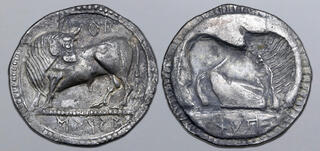Lot description:
Please note this lot is not suitable for US Import.
Lucania, Sirinos (Siris) in alliance with Pyxoes (Pixos) AR Stater. Circa 540-510 BC. Bull standing to left, head reverted; ΣIΡIN-OΣ retrograde in archaic characters below and above / Incuse bull standing to right, head reverted; archaic characters PVX retrograde in exergue. G. Mangieri, 'Sibari Sirino e Pissunte', in RIN 1981, A1 (same dies); Traité 2083, pl. LXVII, 1 (same dies); Perret I (same dies); BMC 2; HN Italy 1723; HGC 1, 1228. 6.83g, 30mm, 12h.
Extremely Fine; dark cabinet tone with traces of original mineral adhesions. Very Rare; an intriguing and historically interesting issue of which very few extant examples are known, with only two specimens recorded from this pair of dies.
Ex Roma Numismatics Ltd., Auction XXV, 22 September 2022, lot 38.
This stater is testament to the alliance of two cities, Sirinos and Pyxoes. The word 'Sirinos', known only from the numismatic record, was at one point considered an adjective referring to the wealthy city of Siris on the Ionian coast, which was destroyed by the alliance of Sybaris, Metapontion and Kroton in the early sixth century BC. However, partly because of the great distance between Siris and Pyxoes it is now thought possible that 'Sirinos' is in fact the name of a city in its own right, likely that of the 'Sirini' people of whom Pliny the Elder writes in his description of southern Italy (NH 3.15). Ruins attributed to Sirinos have been identified on a rocky peak in the valley of Lauria near Rivello, which are still referred to as 'the city', and which geographically would make considerably more sense, being only approximately 30km away from Pyxoes.
Pyxoes itself was an ancient Lucanian city situated on the Tyrrhenian coast, today Policastro Bussentino, and reported by Diodoros Siculus (11.59.4) as having been founded by Mikythos the tyrant of Rhegion and Zankle-Messana in 471/0 BC, possibly as a military outpost, though the numismatic evidence suggests that Pyxoes existed prior to this event; what is not clear is whether it was a Hellenic community prior to Mikythos' refoundation, or whether it was an Italic one. The extent of Pyxoes' territory is uncertain, but it is hard to conceive of it as being autonomous.
Both cities must inevitably have come under the influence of Sybaris, an important city which amassed proverbially great wealth and power due to its fertile land and advantageously positioned port. Indeed, this type of a bull with head reverted and an incuse reverse is directly derived from the contemporary Sybaritic coinage (e.g. HN Italy 1729-1742), the similarities extending as far as the details of the dotted ground line and reverse ray border (S. R. Olsen, 'An incuse stater from the series 'Sirinos/ Pyxoes'', Journal of the Numismatic Association of Australia 26 (2015), p.37.). The incuse design and Achaean weight standard is typical of coinage from the sixth century BC in southern Italy and was also employed in nearby Metapontion and Croton.
Estimate: 10000 GBP |  |